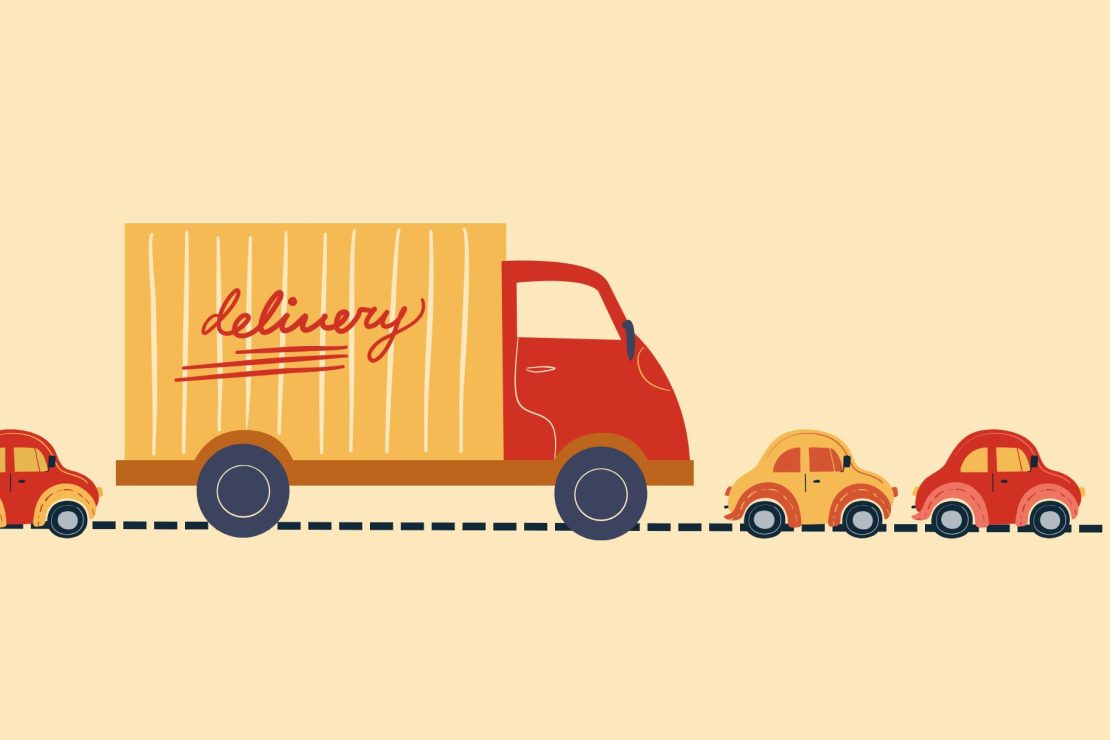Cyclists and pedestrians are making Victoria’s streets greener — and large vehicle owners wary

Graphic by Sage Blackwell.
The transit infrastructure in Victoria B.C. has been undergoing a decade-long overhaul with a focus on sustainability. Bike and bus lanes and pedestrian-only areas have been popping up everywhere in recent years — evidence of the city’s efforts to increase livability, while also moving away from car dependency.
Many Victoria residents have taken to social media to call for a “big truck ban” in the pedestrian-heavy downtown core. Others who still choose to drive — especially in larger vehicles — have other challenges with the reclaimed road space, and increased number of cyclists and pedestrians.
Victoria residents on both sides of the issue continue to sound off online about the validity of vehicle traffic in a city that is moving towards alternative transportation.
For the large number of UVic students who rely on public transit, biking, and walking to get around the city, the expansion of bike and bus lanes, and an increase in pedestrian walkways have made a positive impact.
The City of Victoria’s assistant director of engineering, Ross Kenny, told the Martlet that these changes are all part of the city’s climate action plan.
“Our primary goal is to have 55 per cent of all trips made by walking, rolling, or cycling by the year 2030,” Kenny said.
Kenny emphasized that creating safer, more accessible spaces is essential to this shift.
“Alternative transportation options such as walking, cycling, and public transit take up less physical space than private vehicles … which require parking at both ends of every trip,” he said.
“By expanding these options, we’re not only reducing emissions, but we’re also seeing improved health outcomes, cleaner air, reduced noise pollution, and more freedom for people who can’t drive.”
Caleb Crookes, a UVic student who does not use a car, also sees the infrastructure changes as a positive step for the city.
“The expansion of pedestrian–ization in Victoria is fantastic to see,” Crookes told the Martlet. “Large areas of the city are becoming more accessible to people on bikes and on foot…. The Fort Street bike lanes, for example … make commercial areas a lot easier to access without a car.”
Crookes also noted the growing danger posed by modern trucks and SUVs on Victoria’s streets.
“Modern trucks and SUVs have visibility issues that manufacturers try to solve by adding dozens of exterior cameras,” he said. “Their height poses a tremendous danger, as many of them now have front-end blind spots, meaning drivers can’t see directly in front of them.”
Crookes said larger vehicles are not just dangerous for pedestrians, but for other road users.
“Huge, oversized trucks and SUVs are significantly more dangerous to other vehicles on the road, too. When someone else’s bumper is at your head level in a crash, we have a massive problem,” he said.
For Kenny, balancing the needs of all transportation styles remains a complex task for Victoria.
“We rely on a transportation hierarchy where our number one priority is ensuring pedestrian safety,” he said.
Fred Jenner, general manager of Jenner Chevrolet in View Royal, B.C., says Victoria’s push toward sustainability is not only creating challenges for large vehicle owners — it’s driving changes in vehicle preferences.
“People are second-guessing their purchase decisions,” Jenner said. “We’re seeing more interest in mid-size SUVs, but if you have a large family or need to haul equipment, downsizing just isn’t practical.”
Jenner explained how trucks and SUVs are now bigger than ever. “The Chevy Colorado is now almost as large as the Silverado used to be,” he noted. “People are asking, ‘Where am I going to park this downtown?’”
He explained that while trucks are essential in rural areas, they are often more of a lifestyle choice in the city.
“In Victoria, you see people driving massive trucks alone, and you wonder if they really need it,” said Jenner.
Crookes believes there are better alternatives to suit the city’s evolving infrastructure.
“Pickup trucks aren’t the only option…. Box trucks or Kei trucks would function better for industry … and [would] be safer for everyone,” he said.
Beyond personal preference, talks of a “large vehicle ban” also implicate those who drive large operating vehicles:
“Even with loading bays, delivery vans and trucks end up blocking lanes because there’s just nowhere to park,” said Jenner. “With more people ordering groceries and packages, the number of delivery vehicles on the road is only going up.”
Despite these challenges, Jenner expects large vehicles to remain necessary for certain professions. “If we have an economy that still has, as a contractor needs, lots of delivery services, you’re not gonna get away from that.”
Kenny explained that the city manages delivery truck access through a permit system, and is exploring additional curb space solutions. This will help reduce congestion as residential areas become dense, and the demand for short term loading zones increases.
Kenny also mentioned an ongoing parking modernization review aimed at adapting curb space to the city’s needs.
“A consultant team is conducting a deep dive on parking regulations, covering both off-street development requirements (bike parking and car share vehicles) and on-street policies (metres, time-limited parking, and resident-only parking). This review will result in recommendations to help manage curb space more effectively, and we’ll continually adjust our parking strategy based on changing needs,” he said.
For Crookes, the priority should remain on pedestrian and cyclist safety.
“Even if traffic increases … pedestrian and cyclist safety should come first…. The convenience of one driver shouldn’t outweigh the safety of someone walking on the side of the street or riding a bike,” he said.
Victoria’s challenge is to create a city that supports its environmental goals, while still meeting the needs of all of its residents, whether they bike, walk, or drive.








